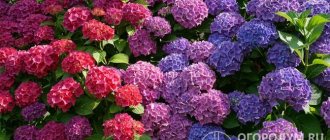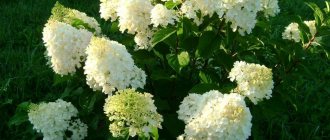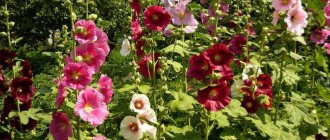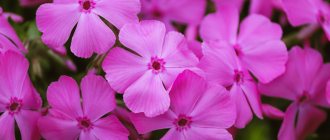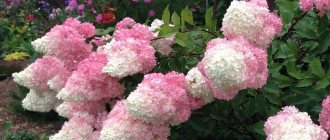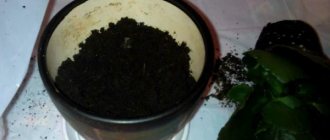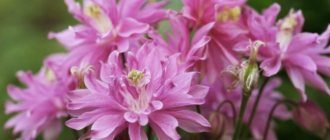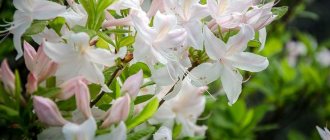Hydrangea is often used to decorate flower beds and lawns in the private sector. This plant is quite bright and attractive. But most inexperienced gardeners sometimes have a question: for what year does hydrangea bloom after planting, and how much care does it require?
This article discusses all the rules for planting and caring for a garden plant so that it pleases its owners with an attractive appearance.
Garden hydrangea
Choosing a healthy seedling
All beautiful hydrangea bushes start with a small seedling. How well the plant will take root in a new place and will delight you with large inflorescences depends on its condition. Therefore, we immediately remember the basic rules for choosing a seedling:
- You need to buy from nurseries and online garden stores.
- You need to choose seedlings with a closed root system. The pot will allow you to keep the hydrangea until the frosts have completely subsided.
- To check the root system, the plant is carefully pulled out of the container along with a lump of earth. The roots should be healthy, moist, without dry shoots, signs of rot or mold.
- The optimal size is 2-4 even, strong shoots.
- For greater guarantee, you can wait until the end of May or the beginning of July and buy a plant that is already vegetating.
- The health of hydrangea is indicated by symmetrical elastic leaves of a rich green color.
Features of hydrangea flowering
Most often, deciduous flower varieties are grown in Russia - they bloom in early summer until the first frosts in autumn. Its flowers are collected in inflorescences - some larger, others smaller, forming a panicle or spherical shape.
The inflorescences can have a wide variety of colors - white and cream, pink and dark gray.
Shades may vary depending on the soil in which the plant is planted:
- if it is planted in neutral soil, the flowers will be light, white or cream;
- with increased acidity it will bloom with bright blue shades;
- at an alkaline level it will be lilac or pink tones.
For what reasons does hydrangea not bloom?
Often a bush does not bloom and in order to make it bloom it is worth finding out the reasons by eliminating them:
- Lack of fertilizer or excessive application of potassium and phosphorus to the soil.
- Excessive pruning of the crown, which does not allow the inflorescences to develop.
- Improper care before wintering or insufficient shelter can cause freezing of the shoot and root system.
- If the buds are damaged - frost, improper pruning or harmful insects.
How to get hydrangea to bloom in the garden?
If it is planted in the ground, you can use the following tips and recommendations to speed up flowering:
- Carry out an early suspension of its growth in November-December, in which case the bush will bloom in early to mid-March.
- To speed up watering, the plant is watered with warm water, the temperature of which is 34-36 degrees.
- When the first shoots and foliage appear, the frequency of watering is doubled, using additional spraying with warm water.
If a flower grows outside in a tub, you can use these techniques to speed up flowering.
- Give the plant a warm bath - place the flowerpot in a basin with warm water, temperature 36-38 degrees, for 8-12 hours.
- If you want to achieve flowering in winter, on New Year's Eve, increase the lighting, bringing it to the length of the summer day, up to 10-14 hours.
Flowering indoor hydrangea
To make your indoor bush please you with abundant color, you should take into account the following recommendations:
- An adult plant is cut 20-25 cm from the ground, planting it in the ground for the winter.
- Next, cover it with spruce branches and dry leaves, and when you open it in the spring, cut it down to ground level.
- At the end of August - beginning of September, plant the hydrangea in a tub.
Ideal place for hydrangea
Hydrangeas are not the most capricious flower, but their location is key. Here you will have to come to terms with it and plant it not where you want, but where it will be best for the plant.
- For paniculate varieties, you need to choose a place with partial shade. In strong sun it shrinks and degenerates, but without light it also feels bad.
- It’s the same with tree hydrangea - the plant loves moderate sunlight without scorching direct rays. Ideally, bushes should be planted near shrubs and trees that will provide them with the necessary protection.
- Petiolate (creeping) species tolerate shade best. They grow well near walls and high fences. Good soil permeability is important for hydrangea.
Where to plant hydrangea
The question of where to plant hydrangea: in the shade or in the sun is quite relevant and interests many lovers of these flowers. This is not surprising, because lighting is one of the main factors that influence the flowering and development of a plant.
Gatsania flower - how it blooms on a club, what soil is needed for growing
In conditions of constant deep shade, hydrangea grows well, gains green mass, but does not form flower stalks. In such conditions the plant will not bloom.
Is it possible to plant hydrangea in the sun? It all depends on the duration and angle of sunlight hitting the plant. With constant light, hydrangea succumbs to stress, flowering becomes short-lived and faded. Direct sunlight burns the leaves and prevents flower stalks from developing to their full potential.
Attention! Hydrangea loves the sun, but the light should be diffused and not scorching. The best option is morning and afternoon lighting. The culture grows well in a slightly shaded place, protected from drafts.
Planting hole size
For active growth and flowering, hydrangea requires nutritious soil. To grow it in areas with poor soil, it is necessary to thoroughly fertilize the planting hole. For a young seedling, prepare a depression measuring 30x30 cm and 40-50 cm deep.
For mature plants, a wider hole will be required. The pit is enlarged if the soil has to be conditioned by adding sand, humus or a nutrient mixture. A distance of 1.5-2.5 meters is maintained between adjacent holes so that adult plants do not interfere with each other.
How to care for a plant in open ground?
For beautiful, lush flowering of hydrangea, proper care is necessary.
Trimming
Hydrangea is one of the garden shrubs that can grow up to 30 cm in height in one season, and therefore this plant needs regular and preventive pruning.
The first is done on plants that have reached 3-4 years of age in early spring before sap flow and buds begin to bloom. You should prune during the period when the buds are swelling.
Important! Too early a procedure will result in unsuitable cuttings for further rooting. If pruning is delayed, the bush may die
. The plant is trimmed with pruning shears, cutting off ¾ of each shoot, leaving 2–3 pairs of buds. It is recommended to renew old bushes, so they are cut off almost to the root.
You can clearly see the procedure for pruning hydrangeas in this video:
Fertilizer
Like any garden plant, hydrangea needs complex fertilizing , which strengthens the branches of the plant, and makes the inflorescences themselves more lush and bright. Fertilizers are applied twice a year:
- In the spring, during the period of bud formation, 20 grams of urea per bucket of water (for an adult plant you will need 3 buckets of solution).
- After flowering, hydrangea is fed with complex mineral fertilizers, which necessarily include: nitrogen, potassium and phosphorus.
Reference! Over time, the acidity of the soil decreases, so it is periodically acidified.
You can learn more about fertilizers for hydrangea from this video:
After flowering
As soon as the hydrangea stops flowering, preparations for winter begin. The first thing to do is remove the flower stalks so that suddenly falling wet snow does not stick to them and break the fragile branches of the plant. There is no need to try to remove them to the very root, just cut them down to the middle. They also perform autumn preventative pruning: get rid of dry, diseased or broken branches.
Caring for shrubs in summer
Summer maintenance of hydrangea involves a set of agrotechnical measures that contribute to the favorable progress of all stages of its growing season:
- Regular watering (once a week - 2-3 buckets of rain or settled water, more often in hot weather).
- Removing weeds and shoots from the root circle, loosening to a depth of 10 cm and mulching up to 3 times per season.
- Adding well-rotted organic matter. The main thing is not to overdo it, otherwise the plants will start to grow uncontrollably. Some gardeners prefer granular organic fertilizers sold in specialty stores.
- A regulating and formative type of pruning to obtain a truly beautiful, flowering and lush bush.
Proper fertilizer when planting
Suitable soil is rare, but it can be adapted so that the hydrangea takes root and begins to grow immediately. For drainage, sand or broken bricks are poured into the bottom of the hole.
The remaining volume is filled with a substrate of excavated soil, humus and high-moor peat. This composition will allow you to grow hydrangea even in a clayey place with poor soil. Recommended proportions: 2 parts each of turf soil and humus and 1 part each of clean sand and peat.
Before planting the seedling, the earthen ball should be lightly shaken off so that the roots straighten and grow faster. The plant goes deep into the prepared nutrient “cocktail” to the level of the root collar.
What year does hydrangea bloom after planting?
As a species, hydrangea can be represented in several forms:
- a bush that forms a fairly spreading form, up to 2 m high;
- a low-growing form of tree, varying in height from 2 to 2.5 m;
- liana-like form, which is capable of expelling a main branch 30 m long.
In their garden plots, gardeners prefer to grow the deciduous form of the plant in the form of a bush, although in nature there are also evergreen varieties of hydrangea.
The leaves of the shrub form can be very different in shape - oval, elongated, have a jagged edge or brightly traced veins.
The inflorescences are quite large, and their shape can be:
- spherical;
- elongated;
- corymboid;
- fruitful.
Corymbose inflorescences of the plant
As for the color, it can be very diverse: from white to deep purple, plain or tinted (when the color changes as the buds bloom).
Note! Flowering occurs in the warm season. It may vary depending on the variety of hydrangea, but in the vast majority of cases it begins in mid-spring and ends with the beginning of autumn.
In addition, many gardeners are also concerned about this point: in what year does hydrangea bloom after planting a cutting?
It is worth noting that if a hydrangea is planted in the autumn, then in most varieties the inflorescences will begin to form the next summer, that is, in fact, when the plant is not yet 1 year old.
But there are other varieties that take several years to produce their first buds.
Flowering calendar for garden hydrangea varieties
Growing hydrangea is not difficult, but it is important to choose the variety that is suitable in each specific case, taking into account its flowering period.
For example, the tree variety is characterized by cold resistance and lush, massive flowering, which lasts from June to the end of September.
Paniculata hydrangea can bloom only in the fourth year after it was planted. As for the duration of flowering, this plant will bloom in July and fade by the end of October. There are a wide variety of paniculate hydrangea varieties, which differ in different flower colors.
Important! This subspecies (for example, the Vanilla variety) is distinguished by the fact that the color of the flowers changes as each flower lives. For example, a white bud that appears will gradually acquire a rich pink hue.
Variety Vanilla
Large-leaved hydrangea has a short flowering period, which lasts about a month (from approximately July to August).
The serrated subspecies has white or blue flowers. It blooms for about 2-3 months, depending on the conditions created.
Hydrangea radiata is distinguished by snow-white flowers that will delight the owner of the garden for 2 to 3 months.
The oakleaf subspecies has snow-white formed inflorescences that gradually change their color, first to pink, and then to a rich purple color.
Why doesn't hydrangea bloom?
There are several reasons why a plant does not bloom, most of which depend on the variety:
- for example, paniculate hydrangea buds may simply freeze over during wintering, so you won’t have to wait for color in the current summer season. Also, the absence of panicles may be caused by inappropriate soil composition;
- large-leaved - may also not survive the winter well, which will negatively affect the formation of color. It should be noted that the plant produces buds only on last year’s branches, so pruning must be done very carefully so as not to rid yourself of the beautiful appearance of the flowering bush;
- Tree hydrangeas, such as the Anabelle variety, may also have trouble blooming. In addition to standard freezing, which is inherent in all subspecies of this plant, the reason may be improper watering. If the soil is too dry, the bush will develop very slowly and will not throw out buds.
Causes such as diseases and various types of infections may also be common to all types. Fungus, powdery mildew or gray mold have a very negative effect on the bush, including its flowering.
Necessary conditions for hydrangea flowering
Many inexperienced gardeners do not know where to plant hydrangea: in the shade or in the sun. This is a very important parameter on which a lot depends.
Hydrangea loves well-lit areas, open but without drafts. At the same time, if direct sunlight falls on the plant for a long period of time, this will negatively affect the appearance of the bush.
Optimal growing location
It is also necessary to select a site whose soil will meet the requirements. It should be slightly acidified and not heavy. The plant does not tolerate clay soils very well. If the land does not comply, then you will have to bring it to the required parameters by adding certain purchased factory microelements, a small amount of sand and peat.
Common mistakes when planting hydrangeas and how to avoid them
Not everyone knows how and where to plant hydrangea: in the shade or in the sun, so that it produces lush flowers.
If such a beauty grows in the garden, but the problem is that it does not bloom, it means that it was not provided with the appropriate conditions. Most likely, the place is too shady for her. The fact is that the bush is quite sensitive to the amount of lighting. If there is not enough sun, the bud simply will not form.
There is another common mistake that inexperienced amateur gardeners make. They place other garden crops too close to the hydrangea. As a result, intertwining, the root systems do not allow each other to fully develop. Therefore, in order for it to bloom, it is necessary to grow it at a certain distance from other neighbors.
Useful tips and some secrets of caring for paniculata hydrangea
First of all, a gardener needs to know whether hydrangea loves sun or shade. In this case, the amount of sunlight should be abundant, but with slight shading, occurring during the period when the sun is at its zenith. These are the most suitable conditions for garden hydrangea to bloom abundantly and for a long time.
If the plant nevertheless begins to bloom, but forms rather small brushes or spheres, then the reason may lie in the fact that the soil does not have enough minerals that provide nutrition to the plant. But you need to be careful with nitrogenous fertilizers, as they affect the amount of green mass formed, and, on the contrary, have a negative effect on the formation of flowers. With hydrangea, you need to adhere to the principle - it is better to underfeed than to overdo it in adding nutrients, be they mineral or organic.
It is also necessary to adhere to the recommended pruning pattern. This will not only help to form a visually attractive bush, but will also contribute to the formation of a large number of flowers.
Frequency and abundance of watering
For their love of moisture, hydrangeas are given the name Hydrangea (water container), so be prepared for frequent watering. Bushes should not be planted in an area where the owners visit only on weekends. For irrigation, you need settled, lukewarm water from the tap or collected rainwater.
When planting, the bush is only sprayed. In the next 2 weeks, the plant is watered once every 2-3 days. Next, simply keep the soil moist, preventing it from drying out. To protect from drying out, the surface around the hydrangea is slightly compacted and mulched with bark, sawdust or pine needles.
What does hydrangea like?
Before planting hydrangeas, it is necessary to take into account the preferences of the crop.
The gardener needs to keep in mind the following nuances:
- Since the hydrangea rhizome grows widely, the plant requires sufficient space on the site.
- Hydrangea prefers humidity. The crop needs frequent watering, but to reduce evaporation from the soil, it is recommended to apply mulch from pine needles to the tree trunk. It should be remembered that watering must be carried out so that there is no stagnation of water.
- The culture needs light and protection from direct sunlight. Hydrangea grows and blooms well in areas with diffuse sunlight, as well as in partially shaded areas.
- Hydrangea prefers well-drained, nutritious soil with high acidity, containing clay particles without excess lime. You can improve the soil composition with compost or humus.
Protection from pests and diseases
For 2-3 years after planting, hydrangea bushes do not require pruning, and the substrate rich in nutrients is enough for the full development of the plant. But the flower may suffer from pests.
Wet soil promotes the development of rot and fungal diseases. If a whitish coating, rusty spots or causeless wilting of foliage appears, you need to remove all damaged parts and treat the hydrangea with a fungicide.
Insecticides help against pests. To combat diseases due to improper care, adjustments are made: hard water is replaced, the amount of fertilizer is reduced.
Proven types of hydrangea
The most unpretentious species are tree hydrangea and paniculata hydrangea. Experienced gardeners usually have no problems with them. Know to water yourself without sparing, fertilize when necessary, and prune if the bush is thickened and the inflorescences are crushed. These hydrangeas overwinter in the middle zone without shelter, but to the north they freeze without it.
Species hydrangeas are gradually being replaced by varieties. Among tree hydrangeas, the most famous is Annabelle, with large caps of snow-white inflorescences. The bush is spreading, in favorable conditions it grows up to 1.5 m. The branches often bend under the weight of the inflorescences, especially after rain. Almost equally popular are Grandiflora with cream and Sterilis with white-green, then whitening petals.
But here are the lesser-known new items: Hayes Starburst with white double flowers, Incredibol / Abitu (first lemon green, then white, and green in the fall). And, of course, pink Invincibelle Spirit!
The most common decorative form of paniculata hydrangea is Grandiflora. When blooming, its inflorescences, up to 30 cm long, are creamy white, then pure white, later turn pink, and in the fall they become greenish-red. Take a closer look at other varieties of paniculata hydrangea. For example, to the dwarf Bobo with a height of 60 - 70 cm. The inflorescences abundantly covering the bush are first in lemon-green tones, then turn white and even slightly pink. Slightly larger than Little Lime. In partial shade, the flowers of this hydrangea are greenish all season, and in the sun by autumn they acquire a pinkish tint. Weems ed / Farbsymfony is larger, 1.5 - 2 m high. The blooming flowers are first creamy white, then pink and wine red by autumn.
Frost-resistant large-flowered hydrangeas
New – hydrangea Endles summer (Endless summer). Pink and blue. Blooming on the shoots of both last and current years! That is, it is remontant and also winters normally in the middle zone. True, with cover.
There are also Tweets and Shout blue and Tweets and Shout pink. And also the Expression variety: its graceful flowers are violet-blue in acidic soil and pink in alkaline soil. All of them can withstand up to -29 °C.
That is, a gardener who takes care of a winter shelter for hydrangea will be able to admire the flowering from July to September - October! The main thing is to open them on time, but not too early in the spring, and in the summer, especially hot ones, to pamper them with watering.
Can I plant in the shade?
Hydrangea is quite shade-tolerant. But the less light, the worse the flowering, and the more sun, the more abundant watering should be. So compromises will have to be made. In the southern regions, plant so that at noon the hydrangea is hidden in partial shade, otherwise you won’t get enough water, and the inflorescences may burn out from direct sun. And in the middle zone it is better to choose a place that is sunny or shaded for a small part of the day.
You definitely can’t plant it with large water-bearing trees, and hydrangea doesn’t get along with a powerful specimen of the girl’s grape; in the summer it won’t have enough moisture even with regular watering. The exception is a very damp area.
Preparing for winter
Many hydrangea varieties are acclimatized for countries with cold climates. For successful wintering, young plants must be insulated. The roots may not be affected, but the young shoots will die from frost.
In the southern regions, hilling is sufficient, but in the northern regions it is necessary to cover with spruce branches, peat and film. The plant can also be placed in a rigid frame and covered with dry leaves or wrapped in hay or straw.
If you figure it out, taming the whimsical hydrangea is not at all difficult. We have broken down the first year of life from planting in open ground to wintering into simple recommendations that will help you grow a beautiful flowering bush from a small seedling.
Useful tips and secrets of care
Caring for thuja in spring and after planting outside
In order for the hydrangea bush to bloom at the right time and for a long flowering period, experienced gardeners advise following some recommendations:
- Feeding is carried out twice. In the spring, nitrogen fertilizers are applied - for the development of the root system and leaf mass, in the summer - potassium preparations (they help strengthen the plant and long-term flowering). In autumn and early spring, organic fertilizer is used: manure, ash, humus.
- The soil is slightly oxidized. To do this, aluminum alum or chelated fertilizers are added to the soil. At home, coffee grounds, tea leaves or citric acid are used. In order to avoid soil alkalinity, it is recommended to replant the indoor plant regularly. It is advisable to mulch garden hydrangea with sawdust and conifer bark.
- When planting a purchased seedling, do not destroy the lump of soil in which the root system of the plant is located. For easier adaptation, gardeners often use the peri-root nutrition method: a small trench with a radius of 20-25 cm is formed around the roots of the hydrangea, into which humus or manure is placed. In this way, plant growth is stimulated and the root system develops. This method of fertilization is also used when it is necessary to transplant a seedling.
Planting a bush
- You can grow a seedling yourself; this material is stronger, easier to master and grows well. Hydrangea is propagated by seeds, cuttings and dividing the bush. Growing a crop by sowing is a rather difficult and painstaking task. It is easier to use the cutting method: a healthy pagon with 2-3 buds is cut off and placed in water. After some time, the cutting is planted in a pot or in open ground in the fall, covered with a glass jar.
- Most hydrangea varieties are pruned in the spring. Any manipulations in the autumn can lead to damage and frostbite of young pagons.
Clipped hydrangea
Advice! Some gardeners do not even remove the last inflorescences - it is believed that they are able to preserve the plant in severe frosts. In autumn, old plantings are rejuvenated.
- Mandatory insulation of bushes for the winter period. It is necessary to mulch the hydrangea, remove the leaves, carefully bend the branches and cover the plant with branches of coniferous trees.
Mulching for the winter
- Adding potassium permanganate to the water when watering and regularly loosening the soil will help to avoid rotting of the roots.
Advice! Hydrangea flowers do not have a pronounced aroma, do not attract bees, and can be planted near paths, windows, and doors.
Flower by the path
How to plant a flower bush correctly
When planting hydrangea on a site, it is important not only to take into account favorable conditions for the plant, but also to follow all the rules for planting it. The sequence of work is as follows:
The sequence of work is as follows:
- determining the planting site, future location of hydrangea bushes, checking the soil for pH;
- digging holes for planting measuring 40cm*40cm*40cm for young seedlings, 50cm*50cm*50cm for perennial shrubs, maintaining a distance of about one and a half meters between them;
- filling planting holes with enriched soil mixed with mineral fertilizers;
- formation of hilly hills from soil in depressions;
- pruning elongated roots of young seedlings;
- pruning shoots and dried inflorescences from old bushes if planting is done in the fall;
- location of seedlings on hills, straightening of roots;
- filling the depressions with the remaining soil, while the last layer should not cover the root collar of the bush;
- abundant watering;
- soil compaction;
- mulching with tree bark and sawdust.
Care after flowering
After flowering is complete:
- Remove dried flower stalks.
- Fertilize the plant. They are fed to stimulate the growth of new shoots and protect against rapid growth of shoots; they should not stretch.
- Bushes are being spudded. New soil is poured under each one, making a slide.
- Mulch the soil. A mixture of compost, manure, peat and humus is poured under each bush in a layer of 5 cm.
Removing old flower stalks is necessary to protect the plant. The panicles, swollen from rain and snow, become very heavy. The stems cannot support the weight and break.
At the end of October, hydrangea is protected from frost. If the winter is snowy, then some varieties can be left without artificial shelter, constructing it from snow. Tree, ground cover and tree hydrangeas tolerate cold well.
Removing panicles
Paniculate and large-leaved (garden) hydrangeas - differences
It happens that paniculate varieties of hydrangea are confused with large-leaved ones.
There are a number of differences:
- The first difference that is immediately visible is the inflorescences:
- in garden hydrangeas they are round, spherical, flattened;
- in paniculata they have the shape of a cone, 15-20 cm long.
- The flowering period is also different:
- paniculata begins to bloom in the second half of summer and blooms until autumn;
- large-leaved blooms earlier.
Soil composition
The soil should be light, nutritious, permeable and acidic.
Peat chips, compost and crushed pine needles are poured into the hole before planting the bush. Soil acidity is increased using ammonium sulfate, sulfuric acid or ferrous sulfate. They are part of most complex fertilizers.
Drainage is made from a mixture of fine expanded clay and leafy soil. Hydrangea grows well on loam, but it is not suitable for rich black soil. Ideal soil composition:
- turf land;
- peat crumb;
- leaf humus;
- coarse sand;
- black soil mixed with coarse sand.
The main components are taken in equal quantities.
Shelter for the winter is necessary to prevent the bushes from freezing
Rules and terms of feeding
The main rule that must be followed when caring for hydrangea. It is better to apply less fertilizer than to exceed the permissible rate. Feed from March to October.
If a gardener grows some exotic variety, then it should be fed only after consulting with specialists who already have experience in growing it.
